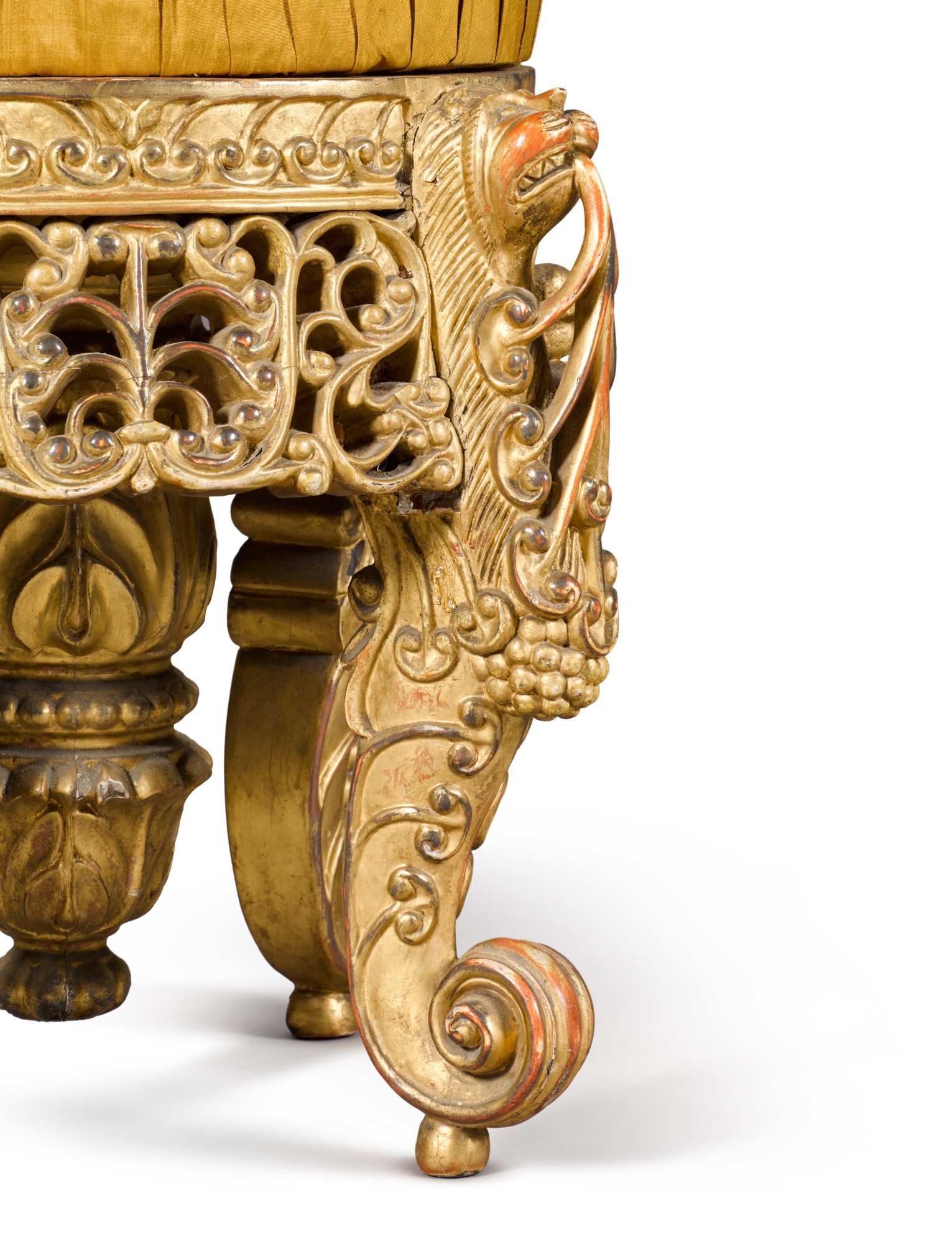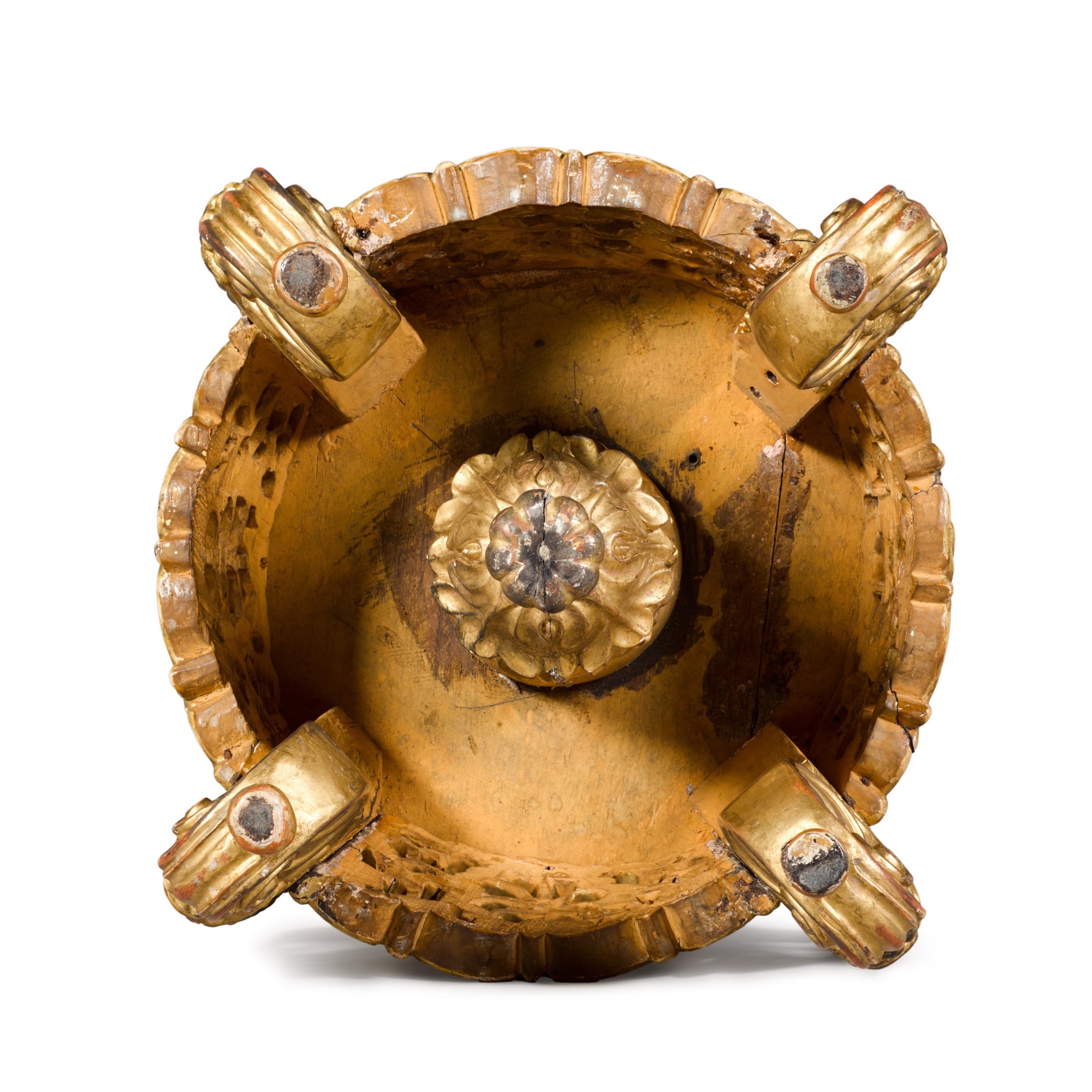50
An Anglo-Indian giltwood piano stool, Bombay, 19th century
with a detachable top rotating on a single screw and covered with later mustard-coloured silk, the four legs with headed with lions issuing stylised tendrils with bunches of grapes and terminating in scroll ends on bun feet, the legs connected by pierced aprons of stylised tendrils and with an extended foliate-carved finial with a pearl collar
This lot will be on view in our New Bond Street galleries on 9th, 10th, 11th, 12th, 15th, 16th and 17th January 2024.
Provenance
Jackson-Stops & McCabe, An interesting sale by auction of the residue 18th, 19th and 20th century furniture at Castletown House, Celbridge, Co. Kildare, 20th April 1966;
Rathbeale Hall, Co Dublin;
Prehen House, Co. Londonderry.
Literature
Georgian Society Records, Dublin, 1913, pl. XXVII
Catalogue note
This suite of furniture is unusual not only in the rarity of its gilt surface, but also the integrity of the suite after more than one and a half centuries of transport and changing hands. They were originally in the collection of Castletown House in Country Kildare, the early eighteenth-century seat of the Conolly family, and have since been held in two other Irish country houses of note.
Anglo-Indian furniture, the loose appellation given to nineteenth-century furniture created in Indian and South Asian colonial territories with a strongly British design influence, drew heavily on local crafts and techniques, and is thus strongly regional in character. The profuse style of pierced carving is typical of the region on the west coast of Indian known as the Bombay Presidency in the 19th century. Carved from the dense blackwood native to the region, the style was in its heyday in the third quarter of the nineteenth century, and Bombay furniture featured prominently in the 1851 Great Exhibition.1 The collection of the Victoria and Albert Museum holds numerous examples of furniture from the Bombay Presidency, and there is also a double-backed chaise longue from Bombay at Charlecote Park, Warwickshire (NT 533027). Though there is considerable variance in decoration between workshops in this style, common motifs include the carved birds that feature on lot 48 and the chair IS.57-1983 in the V&A, and also the lion-form terminal issuing grapes from its mouth, which can be seen on the Charlecote chaise longue, the bergère IS.37-1975 in the V&A and lot 51 in the present group. The all-over foliate carving seen on lots 46 and 49 in the present group, including the foliate clasps to the aprons and the bunches of grapes to the knees, are reproduced almost exactly on chair in the Peabody Essex museum.2
Atypically for this style of furniture, though, the surfaces of these pieces have been entirely gilded, a practice seldom seen within India and therefore most likely to have been executed on arrival in Europe. This is possibly entirely unique, since comparable examples are scarce; the gilt surface is also highly likely to be original from its first arrival in Europe, given that the 1913 photographs of the suite in the Georgian Society Records already show it to be gilded.3 Though the exact date of the purchase of the suite remains unknown, it is recorded in the 1893 inventory of Castletown House described as “Bombay” furniture, not specifying whether gilt or otherwise. They later sold in the April 1966 auction of the property of Castletown, and after a period in Rathbeale Hall, Co. Dublin, have been at Prehen House, Co. Londonderry, where they have frequently been photographed in situ.4
For suites of Bombay blackwood furniture with some similarities in design to the present group, see Sotheby’s New York, 30th October 2013, lot 95, and also Christie’s South Kensington, 25th October 2011, lots 105, 200 and 203.
1 Great Exhibition of the Works of Industry of All Nations, 1851; Official and Illustrated Catalogue, 1851, vol II, p.921. Available at: <https://wellcomecollection.org/works/pdp6m5e3/items?canvas=642&manifest=2> [accessed 17th December 2023]
2 reproduced in Amin Jaffer, Furniture from British India and Ceylon, London, 2001, p.344, fig.159.
3 Georgian Society Records, Dublin, 1913, pl. XXVII.
4 See the archived article of the Northern Ireland Tourist Board on Prehen House, available at <https://web.archive.org/web/20071117190112/https://www.discovernorthernireland.com/product.aspx?ProductID=7814> [accessed 17th December 2023]
with a detachable top rotating on a single screw and covered with later mustard-coloured silk, the four legs with headed with lions issuing stylised tendrils with bunches of grapes and terminating in scroll ends on bun feet, the legs connected by pierced aprons of stylised tendrils and with an extended foliate-carved finial with a pearl collar
This lot will be on view in our New Bond Street galleries on 9th, 10th, 11th, 12th, 15th, 16th and 17th January 2024.
Provenance
Jackson-Stops & McCabe, An interesting sale by auction of the residue 18th, 19th and 20th century furniture at Castletown House, Celbridge, Co. Kildare, 20th April 1966;
Rathbeale Hall, Co Dublin;
Prehen House, Co. Londonderry.
Literature
Georgian Society Records, Dublin, 1913, pl. XXVII
Catalogue note
This suite of furniture is unusual not only in the rarity of its gilt surface, but also the integrity of the suite after more than one and a half centuries of transport and changing hands. They were originally in the collection of Castletown House in Country Kildare, the early eighteenth-century seat of the Conolly family, and have since been held in two other Irish country houses of note.
Anglo-Indian furniture, the loose appellation given to nineteenth-century furniture created in Indian and South Asian colonial territories with a strongly British design influence, drew heavily on local crafts and techniques, and is thus strongly regional in character. The profuse style of pierced carving is typical of the region on the west coast of Indian known as the Bombay Presidency in the 19th century. Carved from the dense blackwood native to the region, the style was in its heyday in the third quarter of the nineteenth century, and Bombay furniture featured prominently in the 1851 Great Exhibition.1 The collection of the Victoria and Albert Museum holds numerous examples of furniture from the Bombay Presidency, and there is also a double-backed chaise longue from Bombay at Charlecote Park, Warwickshire (NT 533027). Though there is considerable variance in decoration between workshops in this style, common motifs include the carved birds that feature on lot 48 and the chair IS.57-1983 in the V&A, and also the lion-form terminal issuing grapes from its mouth, which can be seen on the Charlecote chaise longue, the bergère IS.37-1975 in the V&A and lot 51 in the present group. The all-over foliate carving seen on lots 46 and 49 in the present group, including the foliate clasps to the aprons and the bunches of grapes to the knees, are reproduced almost exactly on chair in the Peabody Essex museum.2
Atypically for this style of furniture, though, the surfaces of these pieces have been entirely gilded, a practice seldom seen within India and therefore most likely to have been executed on arrival in Europe. This is possibly entirely unique, since comparable examples are scarce; the gilt surface is also highly likely to be original from its first arrival in Europe, given that the 1913 photographs of the suite in the Georgian Society Records already show it to be gilded.3 Though the exact date of the purchase of the suite remains unknown, it is recorded in the 1893 inventory of Castletown House described as “Bombay” furniture, not specifying whether gilt or otherwise. They later sold in the April 1966 auction of the property of Castletown, and after a period in Rathbeale Hall, Co. Dublin, have been at Prehen House, Co. Londonderry, where they have frequently been photographed in situ.4
For suites of Bombay blackwood furniture with some similarities in design to the present group, see Sotheby’s New York, 30th October 2013, lot 95, and also Christie’s South Kensington, 25th October 2011, lots 105, 200 and 203.
1 Great Exhibition of the Works of Industry of All Nations, 1851; Official and Illustrated Catalogue, 1851, vol II, p.921. Available at: <https://wellcomecollection.org/works/pdp6m5e3/items?canvas=642&manifest=2> [accessed 17th December 2023]
2 reproduced in Amin Jaffer, Furniture from British India and Ceylon, London, 2001, p.344, fig.159.
3 Georgian Society Records, Dublin, 1913, pl. XXVII.
4 See the archived article of the Northern Ireland Tourist Board on Prehen House, available at <https://web.archive.org/web/20071117190112/https://www.discovernorthernireland.com/product.aspx?ProductID=7814> [accessed 17th December 2023]
Royal & Noble Including Jewels from an Important Noble Collection
Sale Date(s)
Venue Address
General delivery information available from the auctioneer
Sotheby’s Post Sale Service teams can arrange expert delivery and convenient shipping of your property. We offer exceptional service and competitive rates whether shipping a diamond bracelet or a large piece of furniture. Fully knowledgeable on all international regulations, Sotheby's will compile a full range of services for you, including collection, packing and arranging for shipping and transit insurance worldwide. For sales in London and New York, simply provide us with your delivery address when you register for a sale. Following your purchase, we will send you a competitive and comprehensive shipping quote. For property purchased in all other salerooms, contact that office directly to arrange for the transport of your purchases.
To learn more, or if we may be of assistance contact us.
Important Information
https://www.sothebys.com/en/docs/pdf/conditions-of-business-for-buyers-london-27.09.23.pdf?locale=en
Terms & Conditions
https://www.sothebys.com/en/docs/pdf/conditions-of-business-for-buyers-london-27.09.23.pdf?locale=en












